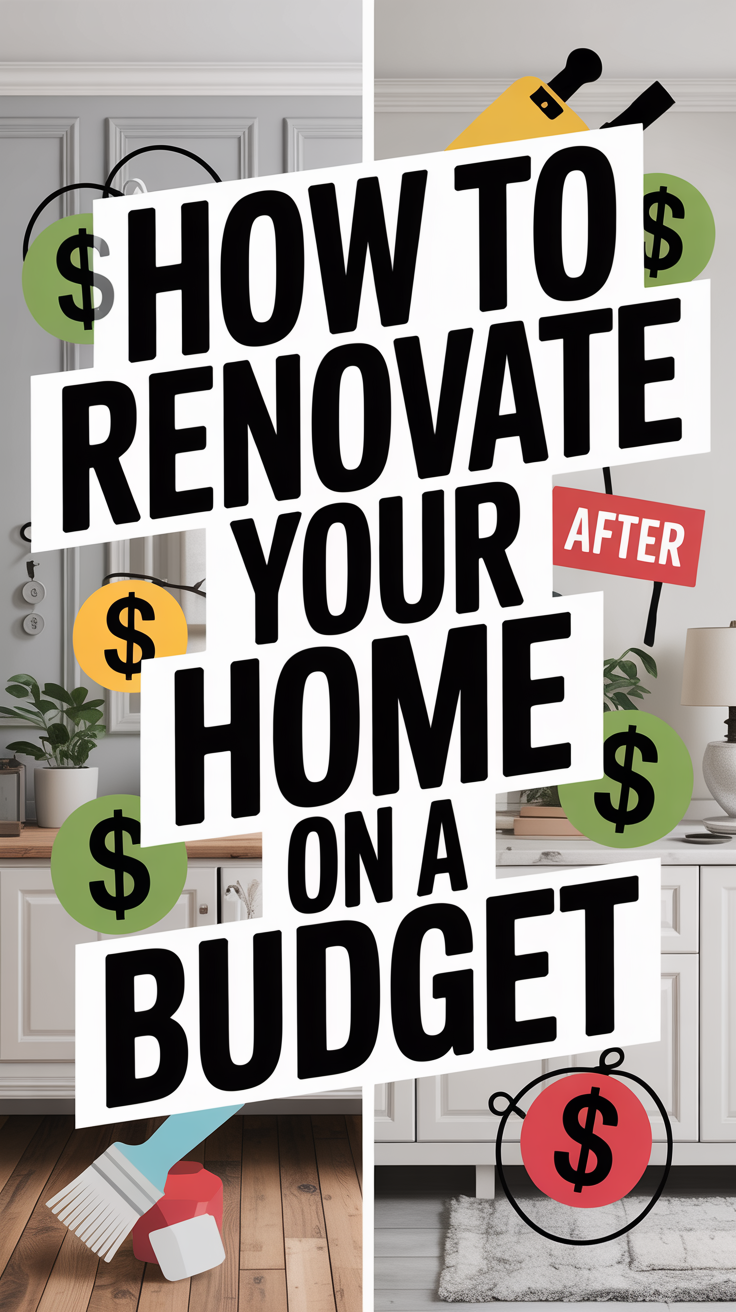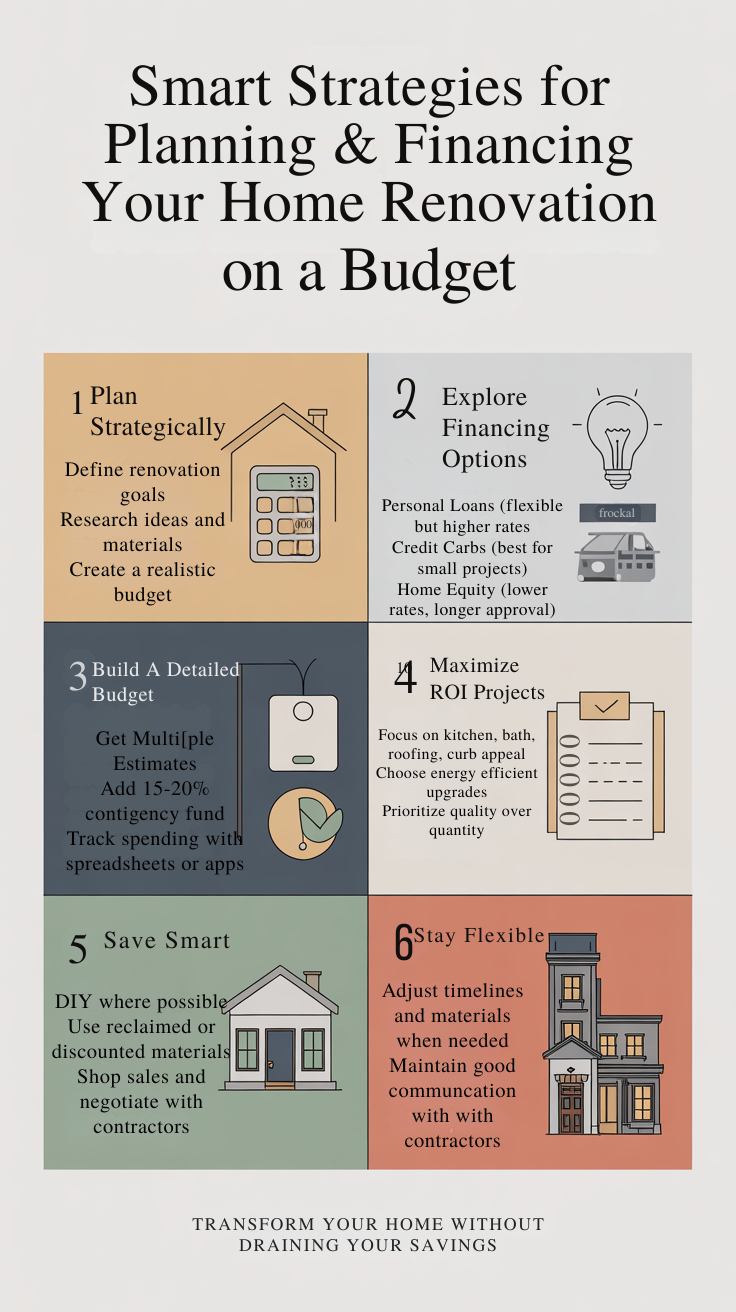How To Renovate Your Home On A Budget
Embarking on a home renovation journey can be both exhilarating and daunting, particularly when financial constraints are a consideration. The prospect of revitalizing your living space brings excitement, but the potential costs can quickly become overwhelming. However, with thoughtful planning, strategic financing approaches, and careful selection of high-impact projects, you can achieve remarkable transformations without depleting your savings.
This comprehensive guide explores proven strategies for planning and financing your home renovation while maintaining strict budget discipline. By following these approaches, you’ll discover how to maximize value and create the home of your dreams without the financial stress that often accompanies major renovation projects.
The Foundation of Successful Renovations: Strategic Planning

Understanding Your Renovation Goals and Priorities
Before selecting paint colors or shopping for fixtures, take time to thoroughly assess your home’s current condition and identify areas requiring attention. Begin by creating a detailed inventory of spaces needing improvement, then establish a clear hierarchy based on necessity, potential value enhancement, and alignment with your lifestyle goals.
This preliminary evaluation serves as the cornerstone of your renovation strategy. Whether you’re modernizing an outdated kitchen, adding a bathroom to accommodate a growing family, or implementing energy-efficient upgrades to reduce utility costs, a clear understanding of your objectives will streamline decision-making throughout the project.
Consider both immediate needs and long-term value when establishing these priorities—some improvements may address current functionality issues while others might significantly increase your property’s market appeal.
Research and Inspiration: Building Your Vision

Effective renovation planning requires thorough research and creative inspiration. Immerse yourself in home improvement resources by exploring specialized magazines, design websites, and social media platforms dedicated to home renovation. Pinterest boards, home improvement blogs, and design forums can provide valuable insights into current trends and timeless approaches.
As you gather ideas, create a digital or physical collection of images and concepts that resonate with your aesthetic preferences and functional requirements. This visual repository will help communicate your vision to contractors and serve as a reference point when making design decisions. Consider utilizing digital design tools or AI-powered home design generators to visualize potential outcomes before committing to specific changes. This research phase establishes a solid foundation for informed decisions about materials, design elements, and overall project scope.
Establishing a Realistic Budget Framework
Creating a comprehensive and realistic budget is perhaps the most critical step before commencing any renovation work. Your budget should encompass all potential expenses, including materials, labor, permits, and a substantial contingency fund for unexpected developments. Be brutally honest about your financial limitations and avoid the temptation to underestimate costs or overextend your resources.
A well-structured budget serves as your financial roadmap throughout the renovation process. It helps prevent costly mid-project adjustments and protects you from significant financial strain. Remember that renovation projects frequently encounter unforeseen challenges—structural issues hidden behind walls, electrical systems requiring updates to meet code requirements, or supply chain disruptions affecting material costs. A contingency fund of 15-20% above your estimated expenses provides essential financial flexibility when these situations arise.
Financing Your Renovation: Understanding Your Options
The financing approach you select can significantly impact both your renovation experience and long-term financial health. Each option presents distinct advantages and considerations that must be carefully evaluated against your specific circumstances.
Personal Loans: Flexibility with Higher Costs
Personal loans have become increasingly popular for home renovation financing due to their accessibility and straightforward structure. These unsecured loans offer fixed interest rates and predictable monthly payments, making budgeting more manageable throughout your project. The absence of collateral requirements means your home isn’t directly at risk if repayment becomes challenging.
However, this convenience comes at a cost—personal loans typically carry higher interest rates than secured financing options. Additionally, loan amounts may be limited based on your credit profile and income, potentially restricting the scope of your renovation. Before pursuing this option, compare offers from multiple lenders to secure the most favorable terms, and carefully assess whether the higher interest costs align with your financial goals.
Credit Cards: Convenience for Smaller Projects

For minor renovations or specific aspects of larger projects, credit cards can provide immediate financing with potential rewards benefits. Many cards offer cashback incentives, points programs, or introductory zero-interest periods that can temporarily reduce financing costs. This approach works well for smaller purchases or when you’re confident in your ability to repay the balance quickly.
The significant drawback to credit card financing lies in the typically high interest rates that apply after any promotional period ends. Carrying substantial renovation costs on credit cards for extended periods can dramatically increase your project’s total cost and create lasting financial pressure. Reserve this option for expenses you can comfortably repay within a short timeframe or strategic purchases that maximize rewards programs.

Home Equity Options: Lower Rates with Greater Responsibility
Home equity loans and lines of credit (HELOCs) allow you to leverage your property’s existing value to finance improvements. These secured financing options typically offer significantly lower interest rates than unsecured alternatives, and the interest paid may qualify for tax deductions depending on your circumstances and current tax laws.
The primary consideration with equity-based financing is that your home serves as collateral, creating foreclosure risk if repayment becomes impossible. Additionally, the approval process can be lengthier and more complex than unsecured options, involving property appraisals and detailed financial verification. These options are best suited for homeowners with substantial equity and stable financial situations who are undertaking significant renovation projects with clear return on investment potential.
Developing a Comprehensive Renovation Budget
Detailed Cost Estimation and Contingency Planning
Begin your budgeting process by obtaining multiple detailed estimates for each component of your renovation. Contact several reputable contractors for comprehensive quotes, research material costs independently, and investigate permit requirements and associated fees. This thorough approach provides a realistic baseline for your budget and highlights areas where costs might be reduced.
Establish a substantial contingency fund—typically 15-20% of your total budget—to address unexpected expenses. Renovation projects frequently uncover hidden issues once work begins, particularly in older homes where outdated wiring, plumbing problems, or structural concerns may lie concealed behind walls or under floors. This financial buffer prevents these discoveries from derailing your project or forcing compromises on quality in other areas.
Strategic Project Prioritization
Not all renovation investments deliver equal returns in terms of home value enhancement or quality-of-life improvement. Focus your resources on projects known to provide strong returns on investment, such as kitchen and bathroom updates, roof replacements, and energy efficiency improvements. These high-impact areas consistently rank among buyers’ top priorities and can significantly influence property valuation.
When working with limited resources, consider the potential return—both financial and functional—of each project component. This strategic approach ensures your investment generates maximum value, whether you’re renovating for personal enjoyment or future resale potential.
Comprehensive Project Documentation
Create a detailed written plan documenting your renovation’s scope, required materials, and expected timeline. This documentation should include specific product selections, quantity calculations, and quality expectations for each project component. A well-defined plan minimizes miscommunication with contractors, reduces the likelihood of costly change orders, and provides a reference point for tracking progress.
This documentation also serves as a valuable tool for identifying potential cost-saving opportunities without sacrificing quality. By clearly defining your requirements, you can more easily evaluate alternative materials or approaches that might reduce expenses while maintaining your design vision.
Diligent Financial Monitoring
Throughout your renovation, maintain rigorous oversight of all expenditures. Regularly compare actual costs against your budget projections and make prompt adjustments when discrepancies arise. Digital budgeting tools or dedicated spreadsheets can simplify this tracking process and provide clear visibility into your financial position at each project stage.
This ongoing monitoring allows you to identify potential budget overruns early, providing the opportunity to make compensatory adjustments in other areas before financial pressures become severe. It also creates accountability for contractors and suppliers, ensuring that agreed-upon pricing is maintained throughout the project.



Maximizing Return on Your Renovation Investment
Enhancing Curb Appeal: First Impressions Matter
The exterior of your home creates critical first impressions that significantly influence perceived value. Strategic investments in landscaping, exterior painting, front door replacement, or updating dated elements like wrought iron fencing can dramatically transform your home’s appearance with relatively modest expenditure.
These exterior improvements often deliver exceptional returns because they affect the initial perception of your entire property. A well-maintained exterior suggests careful attention throughout the home, while neglected curb appeal can diminish the perceived value of even the most beautifully renovated interior spaces. When planning exterior improvements, focus on creating a cohesive, welcoming appearance that complements your home’s architectural style and neighborhood context.
Focusing on High-Impact Interior Spaces
Kitchens and bathrooms consistently rank among the most influential spaces for both homeowner satisfaction and property valuation. Modern, functional kitchens with quality appliances and thoughtful layouts can transform daily living experiences while substantially increasing home value. Similarly, updated bathrooms with contemporary fixtures and efficient designs offer significant returns on investment.
Roofing improvements, though less immediately visible, provide essential protection for your entire home while enhancing overall appearance and structural integrity. These key areas should receive priority consideration when allocating your renovation budget, as they typically deliver the strongest combination of personal benefit and financial return.
Embracing Energy Efficiency
Energy-efficient improvements represent a growing priority for homeowners and potential buyers alike. Upgrades such as enhanced insulation, high-efficiency windows, modern HVAC systems, or solar water heating can reduce ongoing utility expenses while appealing to environmentally conscious consumers. Many of these improvements also qualify for tax incentives, rebates, or special financing programs that can reduce their effective cost.
When evaluating energy efficiency projects, calculate the long-term savings against the initial investment. While some improvements may have longer payback periods, they provide ongoing financial benefits through reduced utility costs and potential tax advantages, in addition to enhancing your home’s marketability.
Prioritizing Quality Over Quantity
When renovation budgets are constrained, focusing on fewer high-quality improvements typically yields better results than attempting to stretch resources across numerous mediocre upgrades. Investing in superior materials and craftsmanship for select projects creates lasting value and distinctive character that budget-conscious alternatives rarely achieve.
Quality renovations withstand the test of time both functionally and aesthetically, reducing future maintenance requirements and preserving their appeal through changing design trends. This focused approach may require postponing some desired improvements, but the resulting quality will provide greater satisfaction and value enhancement in both the short and long term.
Leveraging DIY Opportunities
For homeowners with appropriate skills and tools, personally handling certain aspects of renovation work can significantly reduce labor costs without compromising quality. Painting, landscaping, fixture installation, and basic carpentry are among the tasks many homeowners can successfully manage with proper preparation and research.
Realistically assess your capabilities before committing to DIY approaches. Some projects require specialized skills or equipment that make professional execution more cost-effective when considering potential mistakes, safety concerns, or time investment. Reserve your personal efforts for tasks where you can confidently achieve professional-quality results, and budget for expert assistance with more complex or critical elements.
Practical Strategies for Budget-Conscious Renovations
Creative Material Sourcing and Repurposing
Explore opportunities to incorporate repurposed or creatively sourced materials into your renovation. Refinishing existing cabinetry rather than replacing it entirely, utilizing reclaimed wood for accent features, or repurposing architectural elements can add distinctive character while substantially reducing costs. These approaches often create unique design elements that mass-produced alternatives cannot match.
Consider whether cosmetic updates to existing features might achieve your desired effect without complete replacement. Cabinet refacing, countertop resurfacing, or strategic fixture updates can transform spaces at a fraction of full replacement costs. These approaches also reduce environmental impact by minimizing construction waste.
Strategic Shopping and Negotiation
Develop a disciplined approach to purchasing materials and services for your renovation. Research typical pricing before making commitments, watch for seasonal sales or clearance opportunities, and explore alternative sources including discount retailers, building supply outlets, and online marketplaces. Significant savings are often available for those willing to invest time in comparative shopping.
Don’t hesitate to negotiate with suppliers and contractors, particularly for substantial purchases or comprehensive project scopes. Many vendors have flexibility in their pricing structures, especially when working with informed customers who understand fair market values. Building relationships with local suppliers can also lead to notifications about upcoming sales or special purchasing opportunities.
Phased Implementation Approach
When budget constraints prevent completing all desired improvements simultaneously, develop a strategic phasing plan that prioritizes critical projects while establishing a clear roadmap for future enhancements. This approach allows you to address immediate needs while systematically working toward your complete vision as resources permit.
Carefully plan phase transitions to minimize disruption and avoid damaging completed work during subsequent stages. For example, complete structural modifications before cosmetic improvements, and address systems like plumbing and electrical before installing finishes that would require removal for later access. This thoughtful sequencing prevents costly rework and preserves the value of your initial investments.
Contractor Selection and Management
The professionals you engage can significantly impact both your renovation’s quality and its final cost. Invest time in thoroughly researching potential contractors—review their portfolios, check references, verify licensing and insurance coverage, and evaluate their communication style and responsiveness during the estimation process.
Obtain multiple detailed quotes for comparison, but recognize that the lowest bid isn’t always the best value. Look for contractors who demonstrate clear understanding of your vision, provide comprehensive documentation, and maintain transparent communication about potential challenges. Establish detailed written contracts that specify materials, quality standards, payment schedules, and completion timelines before work begins.
Maintaining Flexibility and Adaptability
Even the most carefully planned renovations encounter unexpected developments that require adjustments. Approaching these situations with flexibility and creative problem-solving can prevent budget overruns while maintaining your project’s essential quality and functionality. Be prepared to consider alternative materials, modified designs, or revised timelines when challenges arise.
This adaptability doesn’t mean compromising on critical elements, but rather recognizing opportunities for strategic adjustments that preserve your renovation’s core value while accommodating real-world constraints. Maintaining open communication with your contractors about priorities and acceptable alternatives facilitates these adjustments when necessary.
Conclusion: Achieving Renovation Success Through Planning and Discipline
Affordable home renovations require thoughtful planning, informed financing decisions, and strategic project selection, but they remain entirely achievable with the right approach. By establishing clear priorities, researching options thoroughly, creating realistic budgets, and implementing disciplined financial management, you can transform your living space without creating financial hardship.
Remember that successful renovations balance immediate desires with long-term value creation. Focus your resources on improvements that enhance both your daily living experience and your home’s market appeal. With careful planning and strategic decision-making, your renovation can deliver a more functional, beautiful, and valuable home while maintaining financial stability.
The journey of home improvement often involves compromise and adjustment, but the satisfaction of creating a space that truly reflects your needs and preferences makes these challenges worthwhile. By applying the strategies outlined in this guide, you can navigate your renovation with confidence, knowing that each decision contributes to both immediate enjoyment and lasting value for your most important investment.



